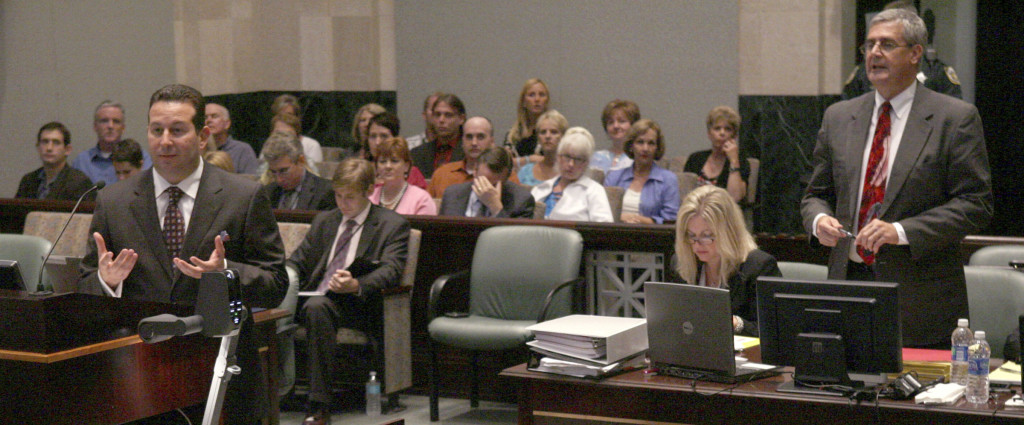Casey Anthony Trial Lawyers Speak Out About the Case’s Controversial Forensics

April 17, 2012
Share
For 33 days last summer, prosecutors and defense attorneys battled over evidence in the trial of Casey Anthony. Anthony stood accused of murdering her two-year-old daughter Caylee in 2008. But while Caylee’s remains were found near the Anthony home, there was no DNA match, no confession, no murder weapon and no cause of death.
To try to prove its case, then, the prosecution called 23 expert witnesses from a variety of forensic disciplines; the defense countered with 14. A debate over forensic evidence was at the center of one of the most widely-watched murder trials since the O.J. Simpson case.
In the process of reporting The Real CSI, FRONTLINE’s examination of the reliability of forensic science, correspondent Lowell Bergman sat down with the two men who had that debate in the courtroom: prosecutor Jeff Ashton and Anthony’s defense attorney Jose Baez. Each gave us their take on the different elements of forensic science brought up during the trial. Click the green tabs above each video to toggle between each lawyer’s argument.
The “Smell of Death”
According to several witnesses, including her own mother, the trunk of Casey Anthony’s car smelled like human decomposition in the summer of 2008. Does this indicate that Caylee’s body had been in it? To accompany lay witness testimony about the smell, Judge Belvin Perry Jr. allowed the prosecution to call Dr. Arpad Vass as an expert witness. Vass, a forensic anthropologist who works out of Oak Ridge National Laboratory, has been studying human decomposition for about 20 years, trying to isolate its signature molecular compounds. This was the first time an odor analysis expert had been allowed to testify in the United States. As you’d expect, Jeff Ashton and Jose Baez have different takes on the merit of Vass’s testimony:
“Consistent With Human Decomposition” “Nowhere Near Ready for a Courtroom”The Heart-Shaped Sticker
A piece of duct tape was found on Caylee Anthony’s skull. When it was analyzed by FBI Fingerprint analyst Elizabeth Fontaine, she says she located the outline of a heart-shaped sticker on it. But she was unable to document the outline, and other analysts weren’t able to verify its presence. Both Baez and Ashton express their doubts about this evidence:
“This Prosecution Was So Desperate” “Not Worth the Time and Effort”The Internet Search for “Chloroform”
The prosecution alleged that Casey Anthony researched ways to subdue or kill her daughter. Central to proving this claim was evidence of a computer search allegedly performed by Casey on how to make chloroform, a chemical used to render a person unconscious. The prosecution presented evidence that someone had made chloroform-related searches 84 times on the Anthony family computer. The defense pointed out that a second test of the same computer showed only one search. And, at one of the most dramatic moments of the trial, Casey’s mother Cindy testified that she looked for chloroform, not Casey. Baez and Ashton agree that the search for “chloroform” probably only occurred once, but they disagree about the relevance of that search:
“Digital Forensics Can Be Flawed” “Someone Typed ‘How To Make Chloroform'”The Verdict
On July 5, 2011, the jury found Casey Anthony not guilty of murder and guilty of four counts of providing false information to police. Ashton and Baez describe their reactions:
It “Started and Ended With Cause of Death” “It Was an Unprovable Case”
Related Documentaries
Latest Documentaries
Related Stories
Related Stories
Policies
Teacher Center
Funding for FRONTLINE is provided through the support of PBS viewers and by the Corporation for Public Broadcasting. Additional funding is provided by the Abrams Foundation; Park Foundation; the John D. and Catherine T. MacArthur Foundation; and the FRONTLINE Journalism Fund with major support from Jon and Jo Ann Hagler on behalf of the Jon L. Hagler Foundation, and additional support from Koo and Patricia Yuen. FRONTLINE is a registered trademark of WGBH Educational Foundation. Web Site Copyright ©1995-2025 WGBH Educational Foundation. PBS is a 501(c)(3) not-for-profit organization.



















